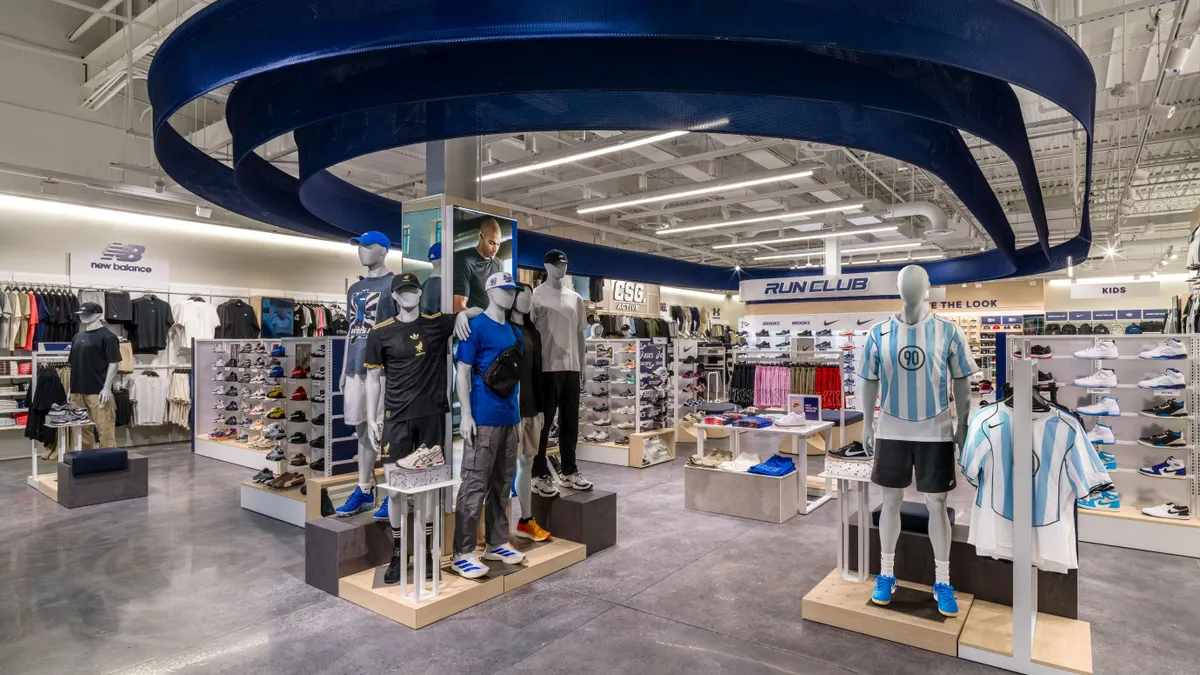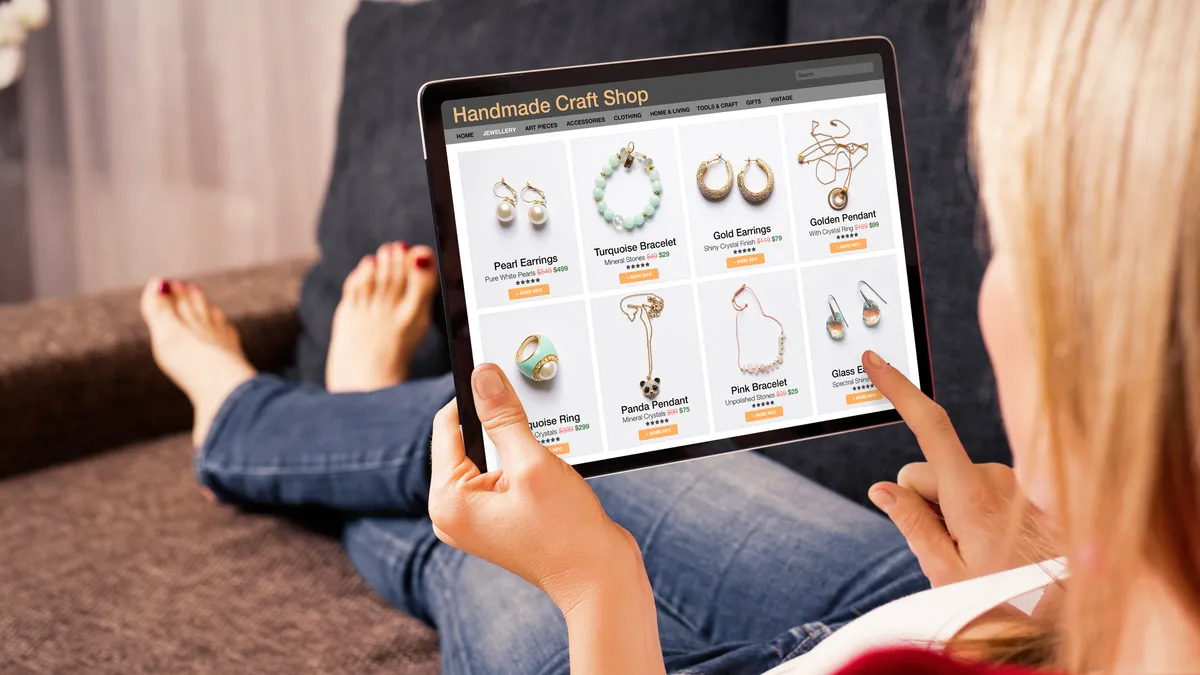When the COVID-19 pandemic temporarily pushed shoppers out of physical stores, consumers turned to e-commerce in droves, giving brands and retailers with a digital presence an advantage. Adobe's Digital Economy Index report released this past March indicated that shoppers spent $183 billion more online from the prior year, bringing total e-commerce spend to $844 billion. With the surge in e-commerce came a boost to online marketplaces, particularly Amazon.
The e-commerce giant saw a 44% increase in online store sales in Q1. Meanwhile, a Marketplace Pulse report found that companies looking to acquire Amazon third-party brands raised $971.5 million throughout 2020.
Now, established retailers and new platforms are looking to get in on the action. Hudson's Bay and Saks Fifth Avenue are each launching online marketplace concepts. And newer platforms like The Fascination and Heyday have raised funds to showcase or support digitally native brands.
As more online marketplaces and companies seek to grow direct-to-consumer brands, DTCs must weigh the benefits of joining each platform with the added costs and potential disconnect between their brands and their customers, sources told Retail Dive. But, if they take customer service cues from online marketplaces, digitally native brands can still attract shoppers to their platform, according to new research.
Changing consumer tastes
Consumers are likely to shop directly with brands if they're able to provide a similar shopping experience as online marketplaces that house products from a variety of retailers, according to a March report from Linnworks, an enterprise commerce automation company. Per the survey, if a brand can offer the same seamless browsing experience and flexible payment options as online marketplaces, then 76% of respondents said they would prefer to shop on a branded site and 85% said they're more likely to shop directly with brands.
Linnworks' report also noted that 60% of millennial and Gen Z respondents said they bought more from DTC brands in 2020 than they had in previous years.
With Amazon, consumers have a lot of choices, but they also can't always get a distinct feel for the brand or a sense of where products originate, said Jason Stuckey, general manager of Linnworks. Gen Z and younger millennials want to understand where products come from and who's making them, and that's part of why they are choosing to shop directly with brands, he said.
DTC brands have excelled with marketing their brand values, which is appealing to younger consumers who care about environmental and social impact, Stuckey said. In addition to promoting their social justice and environmental sustainability values, DTC brands also were early adopters of influencer marketing and social commerce, said Sarah Engel, chief marketing officer and chief people officer at January Digital, a strategic consultancy and media agency.
"So many DTC brands really grew up in social media, so they didn't have to go through this process of discomfort and realignment and having to almost backtrack into it like a traditional brand would," Engel said.
To provide shoppers with the same seamless shopping experience on their own sites, DTC brands must provide benefits like two-day shipping, easy returns, a wide product selection, curbside pickup and buy online, pick up in store, Engel said.
The benefits — and costs — of online marketplaces
Online marketplaces offer DTC brands the chance to reach new customers that might not be aware of the brand, Engel said. DTC brands have realized they must meet customers where they are across all relevant channels, as to not miss shoppers seeking out products directly on Amazon or other marketplaces, experts said.
"A lot of searches for products — people no longer do it on the search site. They're doing it on that marketplace," said Samrat Sharma, who leads U.S. enterprise strategy and growth and the global CMO advisory team for PwC. "Therefore, I think the marketplace — that's going to serve a very important role."
Though online marketplaces offer DTCs the chance to reach more shoppers, they also place an intermediary between new customers, position the brands alongside competitors and charge fees to customize their presence, sources said. Additionally, selling on a marketplace may mean brands lose first-party data, the direct relationship with their customers and control over the brand experience, Engel said.
In general, online marketplaces present most digitally native brands to customers in a modular way that prevents them from creating customized brand aesthetics or experiences, Engel added. Alibaba has long offered brands the ability to create their own stores within the online marketplace, and U.S.-based marketplaces like Amazon are starting to offer that feature in recent years. But that comes at a cost, Sharma said. Brands want to elevate and regain control over the shopping experience on online marketplaces, he said.
"When you go to a marketplace, it's so cookie-cutter. Everybody [is] one-size-fits-all," Sharma said. "But that's not what the brand is. Each brand is unique, and a brand is looking to kind of express its uniqueness."
As the number of online marketplaces grows, DTC brands need to evaluate which ones make sense for their brand based on the marketplace's objective, Sharma said. It wouldn't be wise, for example, for a brand to sell mass-produced products through a marketplace specializing in handmade items, he said.
Before joining a marketplace, DTC companies should ask how much control they'll have over their brand experience, what consumers expect from the platform and what kind of data they can access, Stuckey said. Shoppers on eBay, for instance, expect bargains and refurbished items, so luxury brands might only be interested in that platform if they seek to offload off-season inventory. Getting as much consumer data as possible allows brands to understand the marketplace's customer base and why they shop there, Stuckey added.
They should also only offer their top-selling products on marketplaces, but not their full inventory, so they can have a presence on the platform and deliver a good first impression with new shoppers, Stuckey said.
"Ultimately, if you deliver one really good product to them, the data shows again 76% of consumers want to buy directly from your brand. They'll come back for more if you deliver a really solid product," Stuckey said.
Online marketplaces, particularly eBay and Amazon, have also long battled counterfeit goods sold over their platforms. These platforms have introduced initiatives aimed at stopping the sale of counterfeit goods in order to win back consumer trust, Stuckey said. EBay has launched authentication programs to verify items, such as shoes, high-end watches and sports memorabilia. Meanwhile, Amazon has teamed up with brands, including KF Beauty, Valentino and Salvatore Ferragamo, to sue counterfeiters; launched a counterfeit crimes unit; and piloted third-party seller verification.
Still, the platforms could do more to prevent third-party sellers from listing knockoffs on their platforms. But, even a sale of a counterfeit item is still a sale, Stuckey said. Among those that have removed their brands from the platform was Nike, which did so due to Amazon's consumer data and other business practices, he said.
Driving customers to DTC sites
DTC brands have been testing out other ways to engage with consumers — such as offering extended product trials, and creating classes or other content on their social media — to drive customers directly to their site, Engel said.
Brands have also explored ways to occupy more of consumers' time, she added. For example, Lululemon acquired Mirror to become a part of customers' exercise routines and thus gather data about them.
"It's, yes, the convenience of what you get through a marketplace and adding on that added benefit of content, of quality, of curation, of something extra that's spectacular that makes me want to shop on your site or on your own mobile app versus through the marketplace," Engel said.
The COVID-19 pandemic made e-commerce "an absolute necessity, and it moved our industry forward, many, many years in its advancement," Stuckey said. "It wasn't just that the volume picked up in e-commerce, but it was also in how people shop and where they shop. Consumers are shopping increasingly across a number of different platforms now, more so than they ever were before."




















